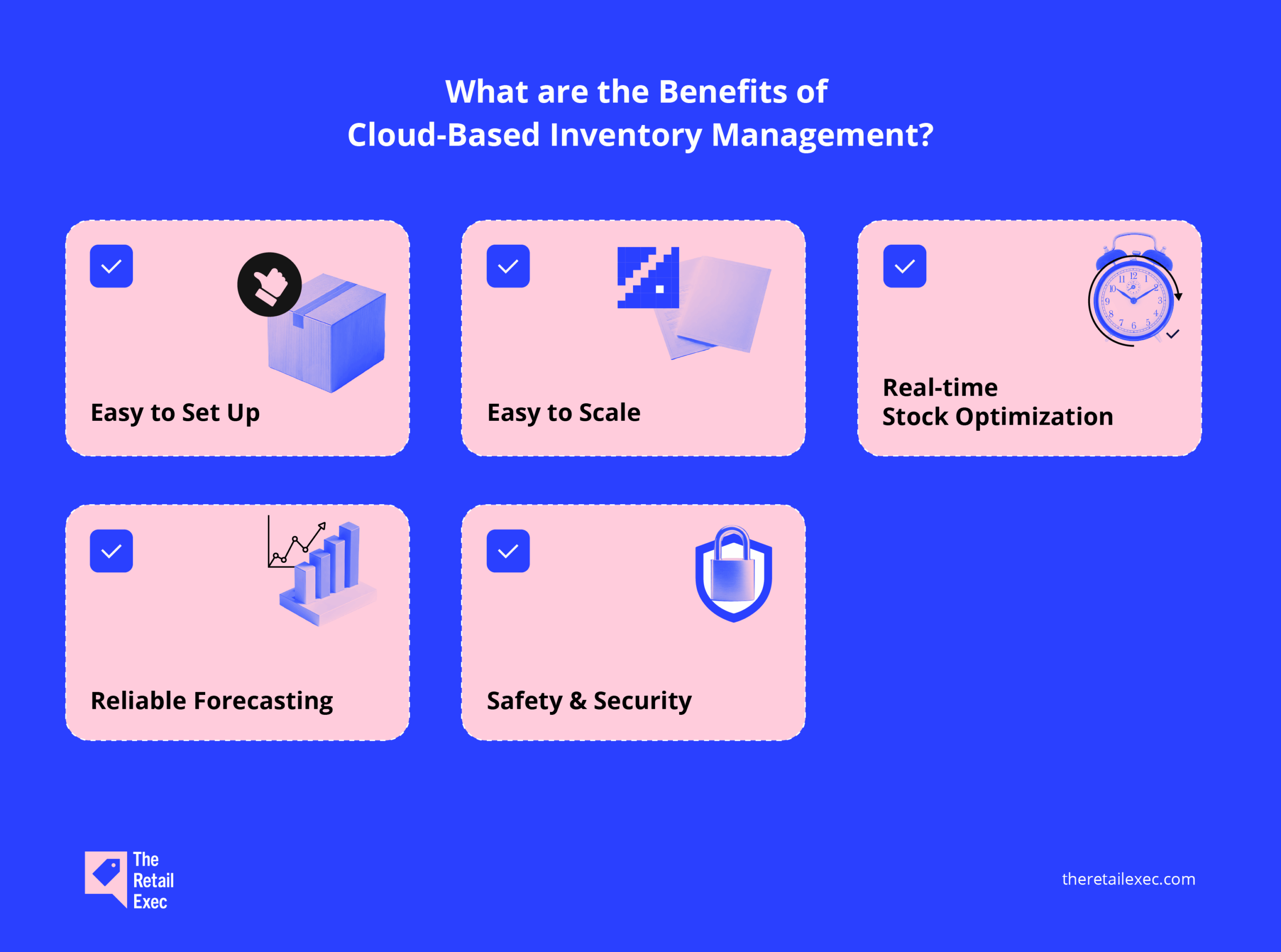Cloudy with a Chance of Streamline: Cloud-based inventory management automates and enhances accuracy, revolutionizing outdated methods and providing a more efficient system for managing inventory across various platforms.
The Warehouse Waltz: Switching to cloud systems helps businesses effortlessly coordinate operations across multiple warehouses, facilitating smoother and more synchronized inventory management.
Bye-Bye, Tedious Tasks!: Cloud systems eliminate the cumbersome manual counting by offering a hands-off approach, allowing businesses to focus on expansion and efficiency.
Tech Transformation Tango: Transitioning from on-premises servers to the cloud is revolutionizing inventory practices, ensuring real-time access and management flexibility like never before.
Accuracy Ascending: Embracing cloud-based inventory systems boosts precision in management tasks, minimizing errors and ensuring operations run smoothly without the usual headaches.
Inventory management has come a long way. What once required pen, paper, and a lot of manual counting work has evolved into a relatively hands-off and more accurate system.
It was a big step to move from manual notation to on-premises computers and servers for inventory. Yet, now that’s even a thing of the past.
Enter cloud-based inventory management software.
We’ll cover how to switch to a cloud-based inventory management system as easily as possible so you can spread your operations across multiple warehouses and marketplaces without headaches.
Let’s answer the key questions you may have. Like, what does cloud inventory do for growing businesses? What are the benefits these software solutions provide? How can it go wrong? Where do I start?
But, first and foremost...
What is Cloud Inventory Management?
Cloud-based inventory management systems are very similar to traditional inventory management software. Both enable you to track your stock wherever it is.
Yet, cloud inventory management takes place in the... you guessed it, cloud. No extra hardware or servers necessary.
Remote servers and the power of the internet allow you to track your inventory across your growing ecommerce empire in real time. Plus, you can automate your inventory control practices to efficiently cut costs, boost profitability, and monitor stock across your whole supply chain.
Obviously, this isn't as easy as flipping a switch.
To get the most out of an inventory management solution, small businesses need to implement a cloud-based inventory management system that's simple and intuitive and preferably doesn't take a grad school education to implement.
But, with the right tool, you can track everything that you own, including raw materials, semi-finished products, machine tools, on-premise desk chairs, sales inventory—everything.
That's a tall order, and you'll need a pretty smart inventory management software to handle the ordering, storing, consumption, and sales volume in a real-time environment.
It would also be nice if you had decent metrics to keep an eye on inventory data, workflows, and forecasting.
Recording inventory levels is one thing, but guessing what you'll need in a month takes a little extra to avoid costly under- and overstocking.
What are the Benefits of Cloud-Based Inventory Management?

There's a lot to recommend the switch to cloud-based inventory management software.
Once you get it set up, cloud-based software is easy to scale, safe, and has the functionality you can use to optimize your stock and forecast your needs for as long a time horizon as you're working from.
1. Easy to set up
To get started with cloud inventory management software, you have to have an internet connection. . . and that's about it.
Because the software is hosted on a remote server, you get the benefits of having a smart IT department to keep you updated on all the latest patches and security settings.
You can also get professional help setting up any configuration you want or making changes as your needs evolve.
2. Easy to scale
Operating from a cloud server is great for a growing business.
Scaling up in the cloud is as easy as asking your host to expand your capacity or add new functionality to your existing package.
Cloud inventory management software like QuickBooks can even scale up by interfacing with other systems.
This includes ecommerce sales tax software, point-of-sale (POS) systems, external marketplaces and other sales channels, 3PL services, ecommerce CRMs, ERPs, and more.
3. Stock optimization in real time
Real-time stock optimization is maybe the biggest step forward in modern inventory management.
In the old days, your order management placed replenishment orders as your stock ran low, usually with a two- or four-week lag.
This is a good way to run out of stock, especially in a time of shortages.
Automatically updating your stock as it moves, rather than when you have a minute to do the books, speeds up your capital and moves more products more efficiently than ever before.
Being able to track inventory in real-time and using forecasting data to make ordering decisions allows you to be agile and always in stock.
The real-time stock optimization feature of cloud-based systems revolutionizes inventory management.
For a more comprehensive understanding of how this impacts your business, explore how inventory management software benefits can streamline your operations.
4. Reliable forecasting
Good forecasting is the flip side of tracking stock effectively.
It's easier to forecast your needs tomorrow than two weeks from now, which is why the real-time tracking cloud-based inventory management software gives you allows you to order as stock gets depleted.
This effectively shortens your forecast horizon to 24 hours from now rather than 24 days like in the past.
Keep in mind that "you get what you pay for" when it comes to ecommerce business intelligence.
You won't have the same sort of forecasting power from free inventory management software as you will from enterprise-grade alternatives.
5. Safety and security
Your inventory numbers are secure documents, and keeping them safe should be a priority for ecommerce retailers in a competitive field.
Cloud-based inventory management software uses industry-standard encryption to keep data confidential, which your customers should appreciate as they send you their credit card information for billing.
How Cloud Inventory Systems Increase Supply Chain Agility
Unpredictable supply chains are the new normal—supplier delays, inventory shortages, freight slowdowns, and demand surges can hit anytime. Your ability to adapt quickly depends on how visible, connected, and responsive your systems are.
Cloud-based inventory platforms give you that edge by keeping data current, automating key processes, and enabling faster decision-making across your supply chain.
Here’s how they make your operations more agile:
- Real-time stock data for faster decisions. Always know what’s in stock, what’s running low, and where inventory is across all warehouses and channels—no manual updates needed.
- Automated reordering based on lead times and demand. Set reorder points that take supplier lead times into account, helping you replenish in time and avoid disruptions.
- Supplier visibility and integration. Track purchase orders, shipment status, and supply availability directly in your platform so you can act quickly when delays or changes come up.
- Multi-warehouse flexibility. Easily transfer stock between locations and reroute fulfillment as needed when inventory is unbalanced or one site runs short.
- Responsive demand planning. Adjust stock allocations on the fly with data from live sales channels and forecasting tools, so you’re ready for unexpected volume spikes or slowdowns.
- Scenario modeling and reporting. Some systems let you simulate supply chain scenarios and generate reports to plan for best- and worst-case situations without the guesswork.
Building an agile supply chain starts with live data and responsive systems—but it also depends on what’s happening inside your operation. That’s where automation takes the wheel.
How Cloud Inventory Systems Automate Warehouse Operations
In the old days, all this tracking was done with a spiral notebook, an abacus, and maybe a spreadsheet if you were fancy.
Thankfully, cloud-based inventory systems have brought automation to the warehouse floor—and it’s not just about speed. It’s about smarter workflows, fewer errors, and total visibility into what’s moving, where it’s going, and when it needs to be restocked.
Here’s what automation looks like when it hits your warehouse:
- Barcode and RFID scanning that talks to the cloud. No more clipboards. Warehouse teams use handheld devices or mobile apps to scan goods as they’re received, picked, packed, or shipped—feeding real-time data into your system automatically.
- Auto-syncing stock levels across every location. As items move in or out of your warehouse, your inventory count adjusts instantly—no human input needed. That means fewer stock discrepancies, and way fewer angry customer emails about out-of-stock items.
- Workflow rules that trigger actions. Set conditions like “if stock hits 20 units, auto-create a purchase order” or “flag this item for priority restock.” You’re not just tracking inventory—you’re setting the system to react for you.
- Smart picking and packing. Some platforms support optimized pick routes, bin location mapping, and wave picking. That means less back-and-forth across warehouse aisles and faster fulfillment.
- Cycle counting that doesn’t interrupt operations. Forget shutting down to audit your stock. With real-time data and automated tracking, you can do continuous inventory checks in small batches—without stopping the flow of orders.
- Automated reporting and dashboards. Cloud-based systems track all the metrics that matter—turnover rates, shrinkage, pick accuracy, fulfillment times—and serve them up in dashboards so you can course-correct on the fly.
Let’s say you’ve got a growing ecommerce apparel brand. You’re not just selling anymore—you’re warehousing, printing, and shipping your own products. That’s a lot of complexity, and doing it manually is a guaranteed mess.
With a cloud-based system, you can track everything: raw materials coming in, printed stock on shelves, what’s shipping out, and where every SKU lives in your warehouse. You’re not just automating; you’re unlocking efficiency at every step.
Automated inventory tracking: fewer errors, more control
Automation doesn’t just improve speed on the warehouse floor—it also transforms how your inventory is tracked, updated, and reported system-wide.
Instead of relying on someone to manually update stock counts or reconcile spreadsheets at the end of the day, cloud-based inventory platforms automatically sync stock levels in real time across all connected systems.
Whether it's an order coming in from Shopify, a product being scanned in at the warehouse, or a refund being processed, every movement updates your inventory count instantly—with no extra clicks, and no room for human error.
This continuous syncing is what powers accurate forecasting, clean audit trails, and real-time inventory valuation. You’ll know what’s in stock and what it’s worth, down to the SKU, at any moment.
That’s a major win for finance teams and operations leads alike.
Even better? Most platforms flag issues before they become problems—like duplicate SKUs, missing product info, or suspicious adjustments.
Combined with detailed activity logs, you get full visibility into what changed, when it changed, and who changed it.
With automated tracking, your inventory data is always one step ahead—clean, current, and ready to support smarter decisions across your business.
How to Choose the Best Cloud-Based Inventory Management System?

There are several cloud-based inventory management software products out there, and if you're going to get a good one, it helps to know what you're looking for.
You want something that's easy to interface with on multiple platforms, integrates multiple functions into a smooth workflow, and optimizes industry best practices to get the most out of the package you're paying for.
Cloud inventory platform features
Everybody needs something different from their cloud solution—but some features are non-negotiable if you care about staying accurate, efficient, and actually in stock.
Here’s what to look for (and why it matters):
- Real-time inventory visibility. Track every SKU, everywhere, at all times. No more guessing—your system should reflect what’s actually on hand, across all channels and warehouses.
- Automated reorder points. Set thresholds that trigger purchase orders or alerts automatically to keep shelves stocked without overbuying.
- Barcode and RFID scanning. Speed up receiving, picking, and audits while cutting out manual entry errors and boosting warehouse accuracy.
- Multi-location and channel syncing. Centralize stock data from all your warehouses, stores, and sales channels so everything updates automatically and plays nice together.
- Forecasting and reporting tools. Use historical data and smart analytics to predict demand, optimize restocking, and avoid dead stock.
- Mobile and remote access. Manage inventory from anywhere with cloud-based dashboards accessible on desktop, tablet, or phone.
- Custom alerts and notifications. Get notified the moment something runs low, stalls, or spikes—via email, SMS, or push—so you can act fast.
- Smart order routing and fulfillment logic. Automatically route orders from the optimal warehouse based on cost, proximity, or stock levels to avoid delays and reduce shipping costs.
- Built-in integrations with your stack. Sync seamlessly with your ecommerce platform, accounting tools, POS, ERP, CRM, and shipping systems to keep operations tight.
- User permissions and roles. Give your team access to what they need—and nothing they don’t—with customizable roles and permissions.
Tailoring your platform to fit your business
Not every ecommerce operation runs the same way, and your inventory platform shouldn’t force you into a one-size-fits-all workflow.
The best cloud-based systems are built to be flexible—so you can configure them around how your business actually works, not the other way around.
Most tools offer modular features, letting you enable only what you need—whether that’s multi-location support, lot tracking, kitting, or B2B portals.
This way, you’re not stuck paying for extra functionality you’ll never use, or struggling to bolt on critical features later.
You can also customize dashboards to focus on the KPIs that matter to your team.
Want to surface reorder alerts, bestsellers, or low-turn stock? You can. Prefer to monitor warehouse efficiency or fulfillment speed? That’s on the table, too.
Workflow rules are another big lever.
You can define how orders get routed, how inventory is allocated, and what triggers specific actions—like stock transfers or supplier reorders—based on your business logic.
Access and visibility can be tailored with user permissions and roles, so your warehouse team, finance lead, and ecommerce manager each get a view that fits their job.
And for teams that run more complex operations or work with a broader tech stack, many platforms offer open APIs and third-party integrations.
That means you can plug in your ERP, CRM, accounting tools, or even custom apps—turning your inventory system into the connective tissue of your operation.
In short, you’re not locked into rigid templates. The right cloud platform becomes a flexible control center built around your brand’s specific needs.
How Much Does Cloud-Based Inventory Management Software Cost?

The cost of cloud-based inventory management software can vary depending on various factors such as the specific features, scalability, user licenses, and the chosen provider.
As you’ll find from our in-depth breakdown of the top cloud-based inventory options, prices can range from as little as $79 per month to as much as $449 per month. Some options go with per-user pricing of anywhere from $24.90 to $49.80 per month.
Obviously, your pricing can depend on your brand’s size and needs.
Larger companies using enterprise inventory management software may pay anywhere from $1,000 to $10,000+ per month.
Some offer tiered pricing plans based on the number of orders or products managed. Basic plans can start at $50 to $100 per month. More advanced plans with unlimited orders or products can reach the higher end of the price range.
We should note that these figures are approximate and can vary significantly depending on the software's capabilities and pricing structure.
Cloud-Based Inventory Tools to Consider
Nowadays, there are tons of options for managing your inventory in the cloud. So many, in fact, that it can be easy to get lost in the search.
Luckily, we’ve got experts who dig through all the SaaS software to give you the facts on the best tools.
From our comprehensive list of the top cloud inventory systems, take a look at our top 10 picks and what they are best for:
Roles and Careers in Cloud Inventory Management
As cloud-based inventory tools become more essential to scaling ecommerce operations, the people managing them are becoming just as critical.
Whether you're hiring for your ops team or looking to pivot into a fast-growing field, here are some of the key roles shaping the future of inventory management in the cloud:
- Inventory manager or operations lead. These are the folks overseeing daily stock levels, order flows, and warehouse coordination. In a cloud environment, they rely on real-time dashboards, forecasting tools, and automated workflows to keep inventory accurate and moving.
- Implementation specialist or systems integrator. Responsible for setting up the inventory software, configuring integrations (with ecommerce, ERP, or shipping platforms), and customizing workflows to fit the business. Often works closely with IT or product teams during onboarding or software changes.
- Inventory analyst. Focuses on the numbers. Analyzes stock trends, forecasts demand, monitors turnover ratios, and surfaces insights to improve purchasing and warehouse strategy. Cloud tools make this job easier by offering rich reporting and live data access.
- Technical support and software trainers. As more ecommerce brands adopt cloud platforms, there's growing demand for experts who can onboard new users, train teams, troubleshoot issues, and help businesses get the most from their tools.
- Solutions consultants and account managers (at SaaS companies). For those working on the software side, these are the people guiding ecommerce clients through tool selection, configuration, and ongoing optimization.
Skills in demand
Across these roles, common skills include:
- Familiarity with inventory and fulfillment workflows
- Experience with cloud-based platforms (like Cin7, inFlow, or NetSuite)
- Understanding of integrations and APIs
- Comfort with data analysis, forecasting, and reporting
- Project management and cross-functional communication
Whether you're a warehouse veteran upskilling into SaaS, or a data-savvy operator stepping into ecommerce logistics, this is a space with expanding opportunities—and a steep learning curve that's worth climbing.
See You in the Cloud?
Just as with anything, inventory management is evolving. And, thankfully so.
It’s easier than ever to see where all your stock is across your scaling ecommerce brand. While you still need to get eyes on stock for cycle counting, there’s no need to maintain those penciled paper records anymore.
Put the abacus away.
Now that you know all about cloud inventory management, it’s time to go find the solution that best fits your brand’s needs.
Retail never stands still—and neither should you. Subscribe to our newsletter for the latest insights, strategies, and career resources from top retail leaders shaping the industry.




